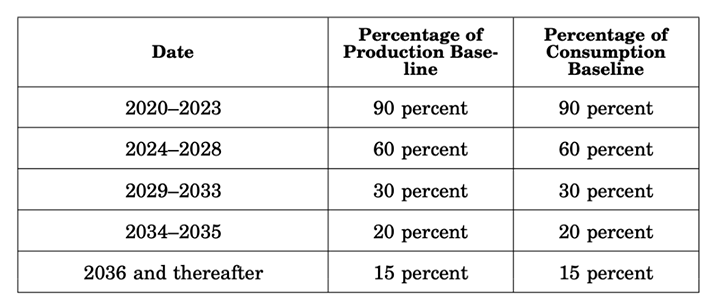A primary purpose of the AIM Act is to reduce the release of HFCs into the environment. HFCs are powerful greenhouse gases that are contributing to global warming.
 What Does the AIM Act Mean for Fire Suppression?
What Does the AIM Act Mean for Fire Suppression?

Article from | Stat-X® Condensed Aerosol Fire Suppression
What is the AIM Act?
The American Innovation and Manufacturing (AIM) Act was passed on December 27, 2020. The AIM Act empowers the Environmental Protection Agency (EPA) to take the following actions regarding hydrofluorocarbons (HFCs):
-
Using a phased approach, steadily reduce the production and consumption of listed HFCs to 15% of the current EPA-established baseline by 2036
-
Provide oversight of the remaining HFCs to optimize reclamation and reduce opportunities for release into the atmosphere
-
Guide the transition to innovative technologies that are free from HFCs
The AIM Act directly affects companies that produce and/or use HFCs in the following industries:
-
Refrigerants
-
Solvents
-
Fire suppressants
-
Foam blowing agents
-
Aerosol propellants
-
Other applications
A primary purpose of the AIM Act is to reduce the release of HFCs into the environment. HFCs are powerful greenhouse gases that are contributing to global warming. This act specifically identifies HFCs because their global warming potential is thousands—in some cases, tens of thousands—times more damaging than carbon dioxide.
The AIM Act received bi-partisan support as well as support from industry. The Act jointly addresses climate change and job creation. From a climate change perspective, it is believed that AIM will help the planet avoid an increase of .5°C in global warming. A half a degree may sound inconsequential, but NASA states that even this very small increase can cause:
-
Heat waves to last a third longer damaging crops and aiding wildfires
-
Rainstorms that are a third more intense with more damaging flooding
-
An increase in sea level that displaces people and consumes coastline
-
Accelerated degradation of coral reefs and damage to the marine ecosystem
On the jobs front, the AIM Act will:
-
Create 150,000 jobs in the US
-
Add $39 billion to the US manufacturing output over seven years
-
Reduce the US/foreign trade deficit in chemicals and equipment by $12.5 billion
-
Provide a savings to US consumers of $3.7 billion over fifteen years
The “innovation” part of the Act is also beneficial. With the EPA tasked to facilitate the next generation of HFC replacements, the onus is on the American manufacturing sector to innovate next-generation products. The Act will stimulate a new wave in US innovation as companies ramp up to locate and produce replacements even more efficient than the HFCs they are replacing.
What are HFCs and why are they so bad?
According to Greenpeace, HFCs were developed as a replacement for chlorinated fluorocarbons (CFCs) that were banned in 1992 by the Montreal Protocol. The reason CFCs were banned is because of their ozone-depleting properties. In the mid to late 1980s, CFCs were discovered to be a prime offender in the depletion and thinning of the ozone layer.
Given the rapid phaseout of CFCs, industry searched frantically for a replacement. In several instances—particularly with refrigerants, foam insulation, and fire suppression agents—HFCs were the answer. But in discovering a solution for one problem, another was created. While HFCs indeed did not possess the ozone-depleting qualities of CFCs, they have come to be considered as potent greenhouse gases with high global warming potential.
Also as reported by Greenpeace, despite efforts of the Montreal Protocol, as far back as 2005 the aggregate pollution from CFCs and HFCs was responsible for almost 20% of the man-made global warming. By the end of this decade, almost 9% of global greenhouse gases will be HFCs. Greenpeace goes on to cite a recent study wherein HFC 134a and HFC 125 (a fire suppressant) emissions are growing at a rate of 20% per year.
The message from Congress and the EPA is that HFCs are bad for the planet, and they need to be reduced dramatically. While some production is scheduled to remain, HFCs have essentially been handed a death sentence.
What does the AIM Act mean for fire suppression agents?
To better understand how AIM will affect fire suppression agents, a short look back to the previous ban of a fire suppression agent is a likely predictor of what will happen with HFCs. In 1993, Dupont® ceased production of Halon®, a top-selling clean-agent that was being phased out under the Montreal Protocol. The market frantically searched to find a replacement. Several manufacturers settled on HFCs, Hydrochlorofluorocarbons (HCFCs), and other fluorine-based chemicals such as fluorinated ketones.
At this point in time, it is the HFC gaseous clean agents that are currently being affected by the AIM Act. However, HFCs were already regulated by the Kyoto Protocol of 1994 on greenhouse gas emissions. The primary HFC fire suppression agents falling under the purview of AIM are: HFC 125 (trade name: FE-25®, and HFC 227ea (FM-200®).
To control production during this phasedown, the EPA will issue “allowances” to those organizations that a) produce or import HFCs and/or b) that use HFCs in one of the six approved applications:
-
As a propellant in metered dose inhalers
-
Defense spray propellant
-
Manufacturing preformed polyurethane foam for marine use and trailer use
-
For etching semiconductor material or wafers
-
Mission-critical military end uses, such as armored vehicle engine and shipboard fire suppression systems
-
On board aerospace fire suppression
An allowance is the unit of measure used by the EPA to control production and consumption. The allowance is valid for one calendar year and is assigned in the preceding October. In order to produce, import, or use one of the regulated HFCs, the company must expend allowances from their bank of assigned allowances from the EPA.
Since the allowances are year-to-year and there is no property right to them, there is no guarantee that the fire suppression agent manufacturers will receive sufficient allowances to maintain continuity. Coupled with this uncertainty is the inevitability that the pool of available allowances will continue decreasing at defined intervals established by the EPA.

With HFC fire suppression agent production and availability decreasing, the price and time spent locating those agents will only increase. Additionally, based on available allowances, and market demand for HFCs in other applications (like refrigeration), the agent manufacturers themselves may opt to cease production, just as Dupont did with Halon.
If the series of events with Halon are to be any guide, HFCs are probably about to enter the annals of fire suppression agent history. The Halon experience also illustrates how being a regulated substance on the Montreal or Kyoto Protocols is likely to produce a need for alternatives. A fire suppression agent which has any global warming or ozone-depleting potential whatsoever is an easy target of this type of action. And they should be; there are options available with zero global warming and zero ozone-depleting properties.
What environmentally stable alternatives are there?
When Halon exited the scene as a fire suppression agent, many companies sought to develop a gaseous agent as close to Halon as possible without the ozone-depleting characteristics. Great Lakes Chemical Corporation (subsequently purchased by Dupont, now known as Chemours), for example, switched from Halon to FM-200 (HFC 227ea). The failure to comprehend that these choices had other negative environmental consequences leads HFCs to today—where Halon was in 1992.
Other manufacturers turned to inert gases such as argon, helium, nitrogen, or some blend. Inert gases are a clean agent that has no environmental impact. They reduce oxygen content to a point where combustion ceases. And unlike CO2, inert gases are safe to use in occupied spaces, provided design concentrations are strictly adhered to.
Others—such as Stat-X®—thought completely out of the box. Fire suppression for spaces normally protected by gaseous systems could be afforded protection without the need for a bank of cylinders, complicated piping, and installation headaches. This allows the fire suppression to be installed in tight, remote, challenging, and hazardous locations as well as where there is no water supply.
The condensed aerosol fire suppression system is a game changer in this space. The compact units deploy a patented mixture of fire suppression chemicals. Upon activation, the condensed aerosol generators produce an exceptionally effective, ultra-fine, potassium-based aerosol. The agent interferes with free radicals produced by the fire to quickly stop its propagation.
As described by the Industrial Safety & Health Review, “the micron-sized aerosol particles exhibit gas-like three-dimensional qualities that allow the agent to rapidly distribute throughout enclosure and to reach even the most concealed and shielded locations. Homogenous distribution is achieved in a matter of seconds, while long holding times all help to prevent fire re-ignition.”
Agents such as Stat-X have zero global warming or ozone-depleting potential. It is UL® listed for normally occupied spaces, so it poses no threat to occupants. Once deployed, the agent does not damage equipment and requires limited cleanup.
In addition to their superior fire suppression capabilities, condensed aerosol generators are self-contained, stand-alone units. They can be installed singly to protect an individual piece of equipment or as a system with multiple generators protecting an enclosure. The electrically operated units can be activated by a fire detection system for a total flooding application. The thermal units can be thermally activated at a pre-determined temperature where a fire detection system is not otherwise present.
Condensed aerosol units are virtually maintenance-free, require no weighing, and have over a fifteen-year lifespan. They are well-suited for harsh environments as well as difficult-to-protect spaces. Protecting those critical, yet remote or rarely visited, enclosures is their domain.
The global acceptance and implementation of condensed aerosol units in all manner of industries—such as energy production and storage, oil and gas, transportation, and manufacturing—is proof that the concept not only works, but it outperforms other agents in almost every category.
About The AIM Act
The AIM Act picks up where Title VI of the Clean Air Act left off after the Montreal Protocol. Just as Halon was a victim of the previous environmental actions, very likely so will be the fate of the HFC agents. As with Title VI and Halon, there will be some remaining stockpiles to service existing systems. However, given the probable outcome, there is almost no value in investing in a new installation of these systems. Condensed aerosol units such as Stat-X offer superior fire protection without any negative environmental impact while avoiding the installation and maintenance expense of piped gaseous systems.
The content & opinions in this article are the author’s and do not necessarily represent the views of AltEnergyMag
Comments (0)
This post does not have any comments. Be the first to leave a comment below.
Featured Product

